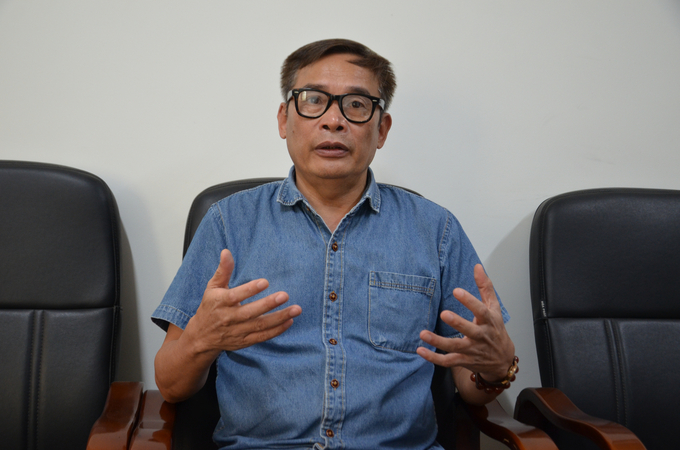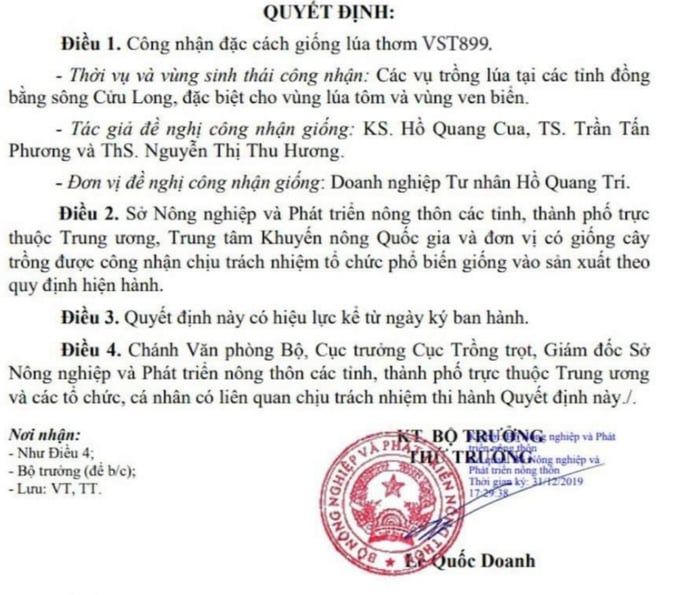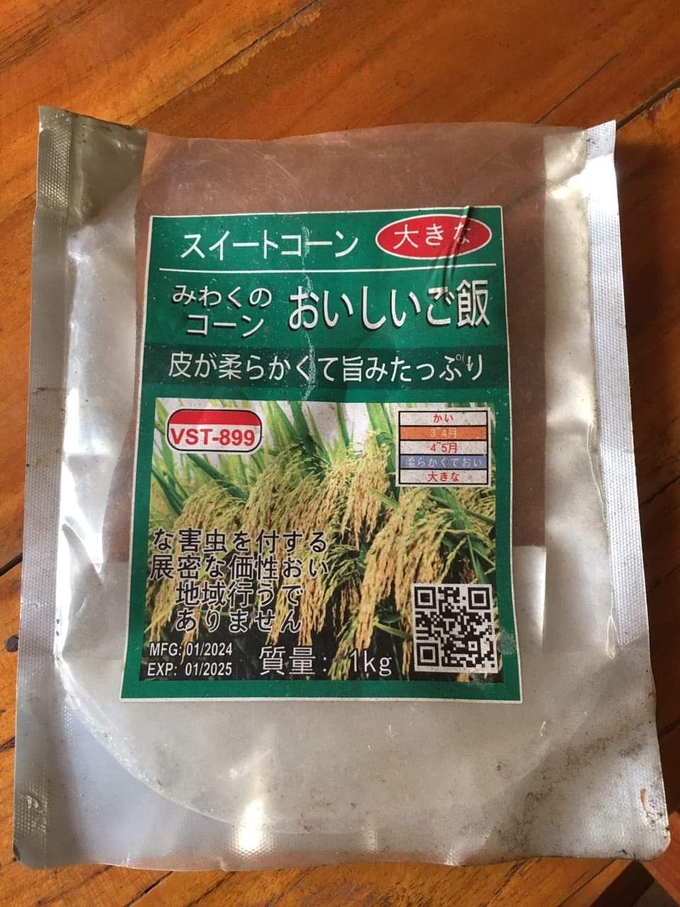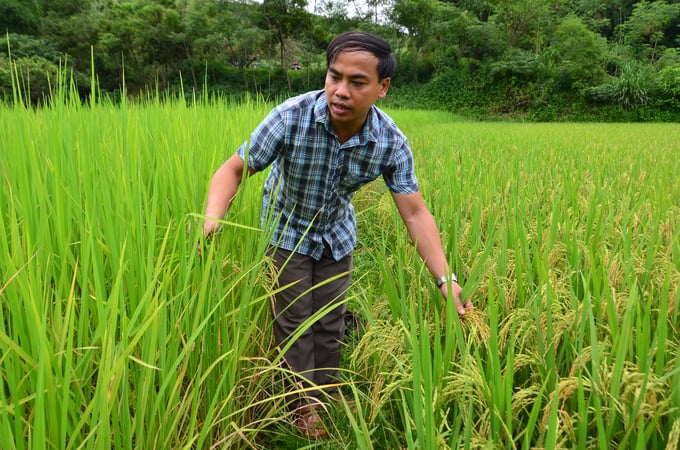October 16, 2025 | 05:30 GMT +7
October 16, 2025 | 05:30 GMT +7
Hotline: 0913.378.918
October 16, 2025 | 05:30 GMT +7
Hotline: 0913.378.918

Mr. Nguyen Nhu Cuong - Director of the Department of Crop Production. Photo: Duong Dinh Tuong.
How do you evaluate the information about fake VST 899 rice variety being widely sold online recently?
I confirm that the VST 889 is a fake variety, a prohibited variety, and that Decision No. 766/QD-BNN-TT dated March 7, 2022, circulating online is fake due to:
Firstly, the VST 899 rice variety has not been granted a decision to announce circulation and has not been registered by any organization or individual to issue a circulation decision.
Second, Decision No. 766, dated March 7, 2022, is fake because, from January 1, 2020, the Law on Crop Production took effect, so the "decision on recognition of plant varieties" was signed by the Director of the Department of Crop Production. Meanwhile, the advertising text on the internet environment is "Decision on official recognition of new plant varieties," stating the legal basis is the 2004 Ordinance on Plant Varieties and Decision 95/2007 is wrong on the legal basis (Plant variety ordinance and guiding documents expire on January 1, 2020).
I heard that in Thai Binh, Ha Nam, Phu Tho, and some other localities, VST 899 rice varieties are sold, but this is due to business on Facebook, YouTube, Zalo, and TikTok. Hence, it causes difficulties for state management agencies in inspection and handling.
We have asked the authorities to get involved. On the other hand, I recommend that localities focus on propaganda through local radio and television systems at the beginning of the production season to raise people's awareness of the issue of fake seeds, especially using the commune-level radio system broadcasting because this is a traditional tool that significantly impacts farmers and is convenient and inexpensive.

The decision to recognize the variety is fake.
Many new or unique plant varieties are currently being advertised on social networks, such as corn with 9-10 ears, corn with ears as big as a thermos, and fruit varieties with unusual colors and shapes... attracting people's attention to buy. How do you feel about that?
As I said above, localities need to focus on propaganda through local radio and television systems when starting the production season to raise people's awareness about the issue of fake seeds, especially using a commune-level radio system because this is a traditional tool that greatly impacts farmers and is convenient and inexpensive.
On the other hand, press agencies must provide information so people can better understand the issue and buy seeds at legally and reputable agricultural supply stores. Second, local specialized agencies provide information to inform people that the final decision to spend money to purchase seeds still belongs to them.
Trading in agricultural materials is a conditional business. Still, we go to many localities, especially in the midlands and mountainous areas, where grocery stores or street vendors in markets also sell agricultural supplies and communes said they did not see the district or specialized agencies inspecting and correcting this phenomenon. What's your opinion?
Decree No. 31/2023/ND-CP of the Government on administrative sanctions in the cultivation field has taken effect. We have enough legal basis to handle violations in the field of seeds. Handling this violation is not only the specialized agencies of the agricultural sector and specialized inspectors but also the police and market management... are responsible for doing so.

Packaging of fake rice variety VST 899.
For a long time, I have felt that in the fight against fake and poor quality seeds, some localities have not paid much attention compared to some other items, and there is a phenomenon where they are openly sold like vegetables and fish in the market. What do you think about that?
The legal documents are complete, and forces such as market management and police... all have the right to inspect and sanction, but why do these forces not pay much attention to fake agricultural materials? The Department of Crop Production has very few people, mainly building the legal corridor, propagating, coordinating, guiding, and disseminating the law. Still, the implementation must be done by localities and agencies such as market management and the police...
If it is related to the smuggling of agricultural materials, the border guards, customs, police, coast guard, market management... are responsible for handling it. Authorities from the Commune People's Committee have the right to impose fines at all levels. As for online business, there are regulations from the Ministry of Industry and Trade and the Ministry of Information and Communications.

On the left is VST 899 rice field without flowering in Tan Son district, Phu Tho province. Photo: Duong Dinh Tuong.
Fake seed advertisements online often impersonate famous companies such as Vinaseed, ThaiBinhseed or Vietnam National University of Agriculture, Agricultural Genetics Institute to attract attention. So what is management responsibility?
The Ministry of Information and Communications manages social networking platforms such as Facebook, YouTube, Zalo, TikTok... I think the authorities managing these platforms need to strengthen the management and filtering of advertisements on these platforms. Social networking platforms such as Facebook, Youtube, Zalo, Tiktok can be accessed anytime, anywhere, just by having a smartphone. Short-term crops such as rice, corn, peanuts, beans... if you buy fake seeds, they will only be affected for a few months, but if you plant industrial crops or long-term fruit trees, the investment is significant, and the time is short. If the investment period is long, the consequences will be very serious and long-term, causing great damage to the people.
On the other hand, it is necessary to disseminate propaganda through many channels and forms so that farmers can change their awareness and decide to buy plant varieties at legal material stores.
The people who buy fake seeds are farmers, most of whom buy because they are gullible, find them cheap, and have attractive advertising. It is necessary to handle those who sell fake seeds strictly. They are not allowed to circulate.

A field planted with fake rice variety VST 899 cannot bloom in Tan Son commune, Tan Son district, Phu Tho province. Photo: Duong Dinh Tuong.
In the past, when cyberspace was not yet developed, fake seeds were easily detected because they were only sold in real space. Nowadays, on the contrary, people selling fake goods think that there is already a safe cyberspace to hide in to sell fake varieties?
What must be done so that those who sell fake goods have no place to exist in any space, real or virtual, like social networks? First of all, Facebook, Youtube, Zalo, Tiktok... must be able to manage sales advertisements, not just people spending money to accept advertising.
Second, the businesses copied or copied from their brands must also coordinate the fight against counterfeit goods and propagandize and change people's perceptions with the authorities.
Thank you so much, Sir!
Translated by Huong Giang

(VAN) The Vietnam Dyke and Disaster Management Authority (Ministry of Agriculture and Environment) received emergency relief supplies from the Australian Government, to assist flood-affected residents in Bac Ninh province.

(VAN) She is Dang Huynh Uc My, Chairwoman of AgriS, and one of the leading female figures in modern agriculture.

(VAN) Scientists have recently announced the discovery of a new mole species in Pu Luong Nature Reserve, contributing to clarifying the evolution and biodiversity of Vietnam.

(VAN) Viet Nam affirms the voice in conservation, highlighting agriculture's role in fostering a harmonious relationship among human and ecosystem.

(VAN) Cat Tien National Park is the only site in Vietnam to receive prestigious tourism awards from the Asian Ecotourism Network.

(VAN) The Viet Nam Fisheries Society (VINAFIS) signed a cooperation agreement with the U.S. Soybean Export Council (USSEC) in Hanoi on the afternoon of October 13.

(VAN) The 2025 International Day for Disaster Risk Reduction calls for investment in community resilience, infrastructure, and educational foundations.